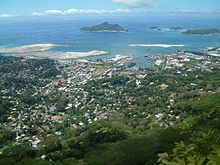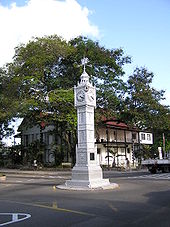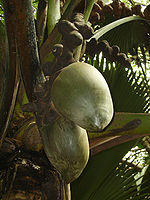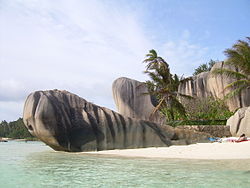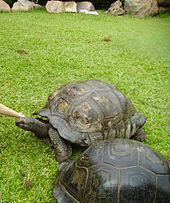- Seychelles
-
Republic of Seychelles Repiblik Sesel
République des Seychelles

Flag Coat of arms Motto: "Finis Coronat Opus" (Latin)
"The End Crowns the Work"Anthem: Koste Seselwa
"Join together all Seychellois"
Capital
(and largest city)Victoria
4°37′S 55°27′E / 4.617°S 55.45°EOfficial language(s) French, English, Seychellois Creole Vernacular language Seychellois Creole Demonym Seychellois, Seychelloise, Seselwa (Creole) Government Republic - President James Michel - Vice President Danny Faure Independence - from the United Kingdom 29 June 1976 Area - Total 451 km2 (197th)
174 sq mi- Water (%) negligible Population - 2009 estimate 84,000[1] (195th) - Density 186.2/km2 (60th)
482.7/sq miGDP (PPP) 2010 estimate - Total $2.129 billion[2] (164th) - Per capita $24,837[2] (37th) GDP (nominal) 2010 estimate - Total $919 million[2] (168th) - Per capita $10,714[2] (53rd) HDI (2007)  0.843 (high) (57th)
0.843 (high) (57th)Currency Seychellois rupee ( SCR)Time zone SCT (UTC+4) - Summer (DST) not observed (UTC+4) Drives on the left ISO 3166 code SC Internet TLD .sc Calling code 248 Seychelles (
 i/seɪˈʃɛlz/ say-shelz; French: [sɛʃɛl]), officially the Republic of Seychelles (French: République des Seychelles; Creole: Repiblik Sesel), is an island country spanning an archipelago of 115 islands in the Indian Ocean, some 1,500 kilometres (932 mi) east of mainland Africa, northeast of the island of Madagascar.
i/seɪˈʃɛlz/ say-shelz; French: [sɛʃɛl]), officially the Republic of Seychelles (French: République des Seychelles; Creole: Repiblik Sesel), is an island country spanning an archipelago of 115 islands in the Indian Ocean, some 1,500 kilometres (932 mi) east of mainland Africa, northeast of the island of Madagascar.Other nearby island countries and territories include Zanzibar to the west, Mauritius and Réunion to the south, Comoros and Mayotte to the southwest. Seychelles, with an estimated population of 86,525, has the smallest population of any African state.[3]
Contents
History
Main article: History of SeychellesScholars assume that Austronesian seafarers, and later Maldivian and Arab traders were the first to visit the uninhabited Seychelles. Remains of Maldivian mariner presence from the 12th century were found in Silhouette Island.[4] The earliest recorded sighting by Europeans took place in 1502 by the Portuguese Admiral Vasco da Gama, who passed through the Amirantes and named them after himself (islands of the Admiral).
A transit point for trade between Africa and Asia, the islands were occasionally used by pirates until the French began to take control starting in 1756 when a Stone of Possession was laid by Captain Nicholas Morphey. The islands were named after Jean Moreau de Séchelles, Louis XV’s Minister of Finance.[5]
The British contested control over the islands between 1794 and 1810. Jean Baptiste Quéau de Quincy, French administrator of Seychelles during the years of war with the United Kingdom, declined to resist when armed enemy warships arrived.[6] Instead, he successfully negotiated the status of capitulation to Britain which gave the settlers a privileged position of neutrality.
Britain eventually assumed full control upon the surrender of Mauritius in 1810, formalised in 1814 at the Treaty of Paris. Seychelles became a crown colony separate from Mauritius in 1903. Elections were held in 1966 and 1970. Independence was granted in 1976 as a republic within the Commonwealth.[7] In 1977, a coup d'état ousted the first president of the republic, James Mancham, who was replaced by France Albert René.[8] The 1979 constitution declared a socialist one-party state, which lasted until 1991. The first draft of a new constitution failed to receive the requisite 60 percent of voters in 1992, but an amended version was approved in 1993.
Politics
Main article: Politics of Seychelles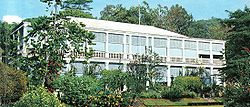 State House, Victoria – the seat of the President
State House, Victoria – the seat of the President
The Seychelles president, who is both head of state and head of government, is elected by popular vote for a five-year term of office. The previous president, France Albert René, first came to power after his supporters overthrew the first president in 1977 and installed him as president, one year after independence. He was reelected thereafter during each election cycle.[8] He stepped down in 2004 in favour of his vice-president, James Michel, who was re-elected in 2006. Michel was reelected in 2011 in an election declared by over 100 international observers, representing Southern African Development Community, the Commonwealth of Nations and the Indian Ocean Commission, as being free and fair,[9] although the opposition parties claim that there was vote-buying.[10][11]
The cabinet is presided over and appointed by the president, subject to the approval of a majority of the legislature.
The unicameral Seychellois parliament, the National Assembly or Assemblée Nationale, consists of 34 members, of whom 25 are elected directly by popular vote, while the remaining nine seats are appointed proportionally according to the percentage of votes received by each party. All members serve five-year terms.
The main rival parties are the ruling socialist Seychelles People's Progressive Front (SPPF), as of 2009 the SPPF became the People's Party (PP) or Parti Lepep (LP), and the liberal democrat Seychelles National Party (SNP). Politics has been an integral part of the lives of the Seychellois since its inception in the early sixties. The range of opinion spans socialist and liberal democratic ideology.
Seychelles is part of the Indian Ocean Commission (IOC), La Francophonie and the Commonwealth of Nations.
Seychelles performed excellently on the 2010 Ibrahim Index of African Governance, ranking 2nd out of 48 sub-Saharan African countries, with an overall score of 79 out of 100, second only to Mauritius, which received a score of 83. Particularly good were its scores in Safety and Security, Participation and Human Rights, and Human Development. The Ibrahim Index is a comprehensive measure of African governance, based on a number of different variables which reflect the success with which governments deliver essential political goods to its citizens.
Subdivisions
Main article: Districts of SeychellesSeychelles is divided into twenty-five administrative regions that comprise all of the inner islands. Eight of the districts make up the capital of Seychelles and are referred to as Greater Victoria. Another 14 districts are considered the rural part of the main island of Mahé with two districts on Praslin and one on La Digue which also includes respective satellite islands. The rest of the Outer Islands are not considered part of any district.
- Greater Victoria
- Bel Air
- La Rivière Anglaise (English River)
- Les Mamelles
- Mont Buxton
- Mont Fleuri
- Plaisance
- Roche Caiman
- Saint Louis
- Rural Mahé
- Anse aux Pins
- Anse Boileau
- Anse Etoile
- Au Cap
- Anse Royale
- Baie Lazare
- Beau Vallon
- Bel Ombre
- Cascade
- Glacis
- Grand'Anse Mahé
- Pointe La Rue
- Port Glaud
- Takamaka
- Praslin
- Baie Sainte Anne (Anse Volbert)
- Grand'Anse Praslin (Grande Anse)
- La Digue and remaining Inner Islands
- La Digue (Anse Réunion)
Education
Main article: Education in SeychellesUntil the mid-19th century, little formal education was available in Seychelles, both the Catholic and Anglican churches opened mission schools in 1851. The missions continued to operate the schools — the Catholic teachers were monks and nuns from abroad — even after the government became responsible for them in 1944. After a technical college opened in 1970, the supply of locally trained teachers began to grow, and in short time many new schools were established. Since 1981 a system of free education has been in effect requiring attendance by all children in grades one to nine, beginning at age five. Ninety percent of all children also attend nursery school at age four.
The literacy rate for school-aged children rose to more than 90 percent by the late 1980s. Many older Seychellois had not been taught to read or write in their childhood, but adult education classes helped raise adult literacy from 60 percent to a claimed 85 percent in 1991.
Currently the public school system consists of 23 crèches, 25 primary schools and 13 secondary schools. The schools are located on Mahé, Praslin, La Digue and Silhouette. There are also three private schools: École Française, International School and the Independent school. All three private schools are located on Mahé, but the International School has a branch on Praslin. There are seven post secondary (non-tertiary) schools. They are the Seychelles Polytechnic, School of Advanced Level Studies, National Institute of Education, Seychelles Institute of Technology, Maritime Training Centre, Seychelles Agricultural and Horticultural Training Centre and the National Institute for Health and Social Studies.
The current administration has advanced plans to open a university on the islands in an attempt to slow down the brain drain that has occurred in the past. Initiated in conjunction with the University of London, the Seychelles are launching education programmes which will include teaching and lead to the award of the recognised qualifications from the University of London.
Geography
Main article: Geography of SeychellesAn island nation, Seychelles is located to the northeast of Madagascar and about 1,600 km (994 mi) east of Kenya. The number of islands in the archipelago is often given as 115 but the Constitution of the Republic of Seychelles lists 155. The islands as per the Constitution are divided into various groups as follows.
There are 42 granitic islands, in descending order of size: Mahé, Praslin, Silhouette Island, La Digue, Curieuse, Felicite, Frégate, Ste-Anne, North, Cerf, Marianne, Grand Sœur, Thérèse, Aride, Conception, Petite Sœur, Cousin, Cousine, Long, Récif, Round (Praslin), Anonyme, Mamelles, Moyenne, Ile aux Vaches Marines, L'Islette, Beacon (Ile Sèche), Cachée, Cocos, Round (Mahé), L'Ilot Frégate, Booby, Chauve Souris (Mahé), Chauve Souris (Praslin), Ile La Fouche, Hodoul, L'Ilot, Rat, Souris, St. Pierre (Praslin), Zavé, Harrison Rocks (Grand Rocher).
There are two coral sand cays north of the granitics: Denis and Bird.
There are two coral islands south of the granitics: Coëtivy and Platte.
There are 29 coral islands in the Amirantes group, west of the granitics: Desroches, Poivre Atoll (comprising three islands — Poivre, Florentin and South Island), Alphonse, D'Arros, St. Joseph Atoll (comprising 14 islands — St. Joseph Ile aux Fouquets, Ressource, Petit Carcassaye, Grand Carcassaye, Benjamin, Bancs Ferrari, Chiens, Pélicans, Vars, Ile Paul, Banc de Sable, Banc aux Cocos and Ile aux Poules), Marie Louise, Desnoeufs, African Banks (comprising two islands — African Banks and South Island), Rémire, St. François, Boudeuse, Etoile, Bijoutier.
There are 13 coral islands in the Farquhar Group, south-southwest of the Amirantes: Farquhar Atoll (comprising 10 islands — Bancs de Sable Déposés Ile aux Goëlettes Lapins Ile du Milieu North Manaha South Manaha Middle Manaha North Island and South Island), Providence Atoll (comprising two islands — Providence and Bancs Providence) and St Pierre.
There are 67 raised coral islands in the Aldabra Group, west of the Farquhar Group: Aldabra Atoll (comprising 46 islands — Grande Terre, Picard, Polymnie, Malabar, Ile Michel, Ile Esprit, Ile aux Moustiques, Ilot Parc, Ilot Emile, Ilot Yangue, Ilot Magnan, Ile Lanier, Champignon des Os, Euphrate, Grand Mentor, Grand Ilot, Gros Ilot Gionnet, Gros Ilot Sésame, Heron Rock, Hide Island, Ile aux Aigrettes, Ile aux Cèdres, Iles Chalands, Ile Fangame, Ile Héron, Ile Michel, Ile Squacco, Ile Sylvestre, Ile Verte, Ilot Déder, Ilot du Sud, Ilot du Milieu, Ilot du Nord, Ilot Dubois, Ilot Macoa, Ilot Marquoix, Ilots Niçois, Ilot Salade, Middle Row Island, Noddy Rock, North Row Island, Petit Mentor, Petit Mentor Endans, Petits Ilots, Pink Rock and Table Ronde), Assumption, Astove and Cosmoledo Atoll (comprising 19 islands — Menai, Ile du Nord (West North), Ile Nord-Est (East North), Ile du Trou, Goëlettes, Grand Polyte, Petit Polyte, Grand Ile (Wizard), Pagode, Ile du Sud-Ouest (South), Ile aux Moustiques, Ile Baleine, Ile aux Chauve-Souris, Ile aux Macaques, Ile aux Rats, Ile du Nord-Ouest, Ile Observation, Ile Sud-Est and Ilot la Croix).
Climate
The climate is equable although quite humid, as the islands are small.[12] The temperature varies little throughout the year. Temperatures on Mahé vary from 24 to 30 °C (75 to 86 °F), and rainfall ranges from 2,900 mm (114 in) annually at Victoria to 3,600 mm (142 in) on the mountain slopes. Precipitation is somewhat less on the other islands. During the coolest months, July and August, it drops to as low as 24 °C (75 °F). The southeast trade winds blow regularly from May to November, and this is the most pleasant time of the year. The hot months are from December to April, with higher humidity (80%). March and April are the hottest months, but the temperature seldom exceeds 31 °C (88 °F). Most of the islands lie outside the cyclone belt, so high winds are rare.[13]
Economy
Main article: Economy of SeychellesDuring the plantation era, cinnamon, vanilla, and copra were the chief exports. In the 1960s, about 33% of the working population worked at plantations, and 20% worked in the public or government sector. In 1971, with the opening of Seychelles International Airport, tourism became a serious industry, basically dividing the economy into plantations and tourism. The tourism sector paid better, and the plantation economy could only expand so far. The plantation sector of the economy declined in prominence, and tourism became the primary industry of Seychelles.
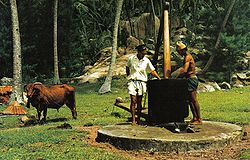 Coconut oil making in the early 1970s
Coconut oil making in the early 1970s
Since independence in 1976, per capita output has expanded to roughly seven times the old near-subsistence level. Growth has been led by the tourist sector, which employs about 30% of the labour force, compared to agriculture which today employs about 3% of the labour force. Despite the growth of tourism, farming and fishing continue to employ some people, as do industries that process coconuts and vanilla. The prime agricultural products currently produced in the Seychelles include sweet potatoes, vanilla, coconuts, and cinnamon. These products provide much of the economic support of the locals. Frozen and canned fish, copra, cinnamon, and vanilla are the main export commodities of the islands.
In recent years the government has encouraged foreign investment in order to upgrade hotels and other services. These incentives have given rise to an enormous amount of investment in real estate projects and new resort properties, such as project TIME, distributed by the World Bank, along with its predecessor project MAGIC.[citation needed] Despite its growth, the vulnerability of the tourist sector was illustrated by the sharp drop in 1991–1992 due largely to the Gulf War.[14] Since then the government has moved to reduce the dependence on tourism by promoting the development of farming, fishing, small-scale manufacturing and most recently the offshore financial sector, through the establishment of the Seychelles International Business Authority (SIBA) and the enactment of several pieces of legislation (such as the International Corporate Service Providers Act, the International Business Companies Act, the Securities Act, the Mutual Funds and Hedge Fund Act, amongst others).
Other issues facing the government are the curbing of the budget deficit, including the containment of social welfare costs, and further privatisation of public enterprises. The government has a pervasive presence in economic activity, with public enterprises active in petroleum product distribution, insurance (has now been privatized), banking (is being privatized very soon), imports of basic products (now being privatized), telecommunications (four private ISP/telecom companies), and a wide range of other businesses.
Demographics
Main article: Demographics of SeychellesSee also: Indo-Seychellois, Sino-Seychellois, Seychellois Creole People, Seychellois Creole, and Franco-SeychelloisWhen the British gained control of the islands during the Napoleonic Wars, they allowed the French upper class to retain their land. Both the French and British settlers used enslaved Africans and although the British prohibited slavery in 1835, Africans continued to be enslaved. Thus the Gran'bla ("big whites") of French origin dominated economic and political life. The British administration employed indentured servants from India to the same degree as in Mauritius resulting in a small Indian population. The Indians, like a similar minority of Chinese, were confined to a merchant class.[15] Today the descendents of the Indian, Chinese, and Gran'bla form distinct ethnic communities, although most people are of 'black' African origin, often mixed with 'white' European or Asian heritage.[citation needed]
As the islands of Seychelles had no indigenous population, the current Seychellois are composed of people who have emigrated to the island. The largest ethnic groups are those of African, French, Indian, and Chinese descent. French and English are official languages along with Seychellois Creole, which is primarily based upon French. Turkish, Spanish, and Arabic are spoken by a small part of population as secondary languages.
According to the 2002 census, most Seychellois are Christians: 82.3% are Roman Catholic, 6.4% are Anglican, and 4.5% are of other Christian denominations. There are also small minorities that practice Hinduism (2.1%) and Islam (1.1%). Other non-Christian faiths account for 1.5% of the population while a further 2.1% were non-religious or did not specify a religion.[16] The total median age of Seychellois is 32 years.[17]
Culture
Seychellois society is essentially matriarchal.[18][19] Mothers tend to be dominant in the household, controlling most current expenditures and looking after the interests of the children.[18] Unwed mothers are the societal norm, and the law requires fathers to support their children.[19] Men are important for their earning ability, but their domestic role is relatively peripheral.[18] Older women can usually count on financial support from family members living at home or contributions from the earnings of grown children.[18]
The music of Seychelles is diverse. The folk music of the islands incorporates multiple influences in a syncretic fashion, including African rhythms, aesthetic and instrumentation – such as the zez and the bom (known in Brazil as berimbau), European contredanse, polka and mazurka, French folk and pop, sega from Mauritius and Réunion, taarab, soukous and other pan-African genres, and Polynesian, Indian and Arcadian music.[citation needed] A complex form of percussion music called contombley is popular, as is Moutya, a fusion of native folk rhythms with Kenyan benga.
Traditionally, despite a greater connection with Great Britain (e.g., in education, which follows the International General Certificate of Education (IGCSE), and on many aspects of the law) many foreign observers[who?] have stated that "the culture remains emphatically French" and about 70% of the population have a family name of French origin, compared with only about 20% family names of English origin.[citation needed] The two are often mixed, such that inhabitants receive an English first name and a French family name or vice-versa (e.g., Jean-Pierre Kingsmith).
Flora and fauna
Main article: Flora and fauna of SeychellesEnvironmental legislation is very strict,and every tourism project must undergo an environmental review and a lengthy process of consultations with the public and conservationists. The Seychelles is a world leader in sustainable tourism. The end result of this sustainable development is an intact and stable natural environment, which attracts financially strong visitors (150,000 in 2007) rather than short-term mass tourism. Since 1993 a law guarantees the citizens the right to a clean environment and at the same time obliges them to protect this environment. The country holds a record for the highest percentage of land under natural conservation—nearly 50% of the total land area of the Seychelles.[citation needed]
Anse Source d' Argent on La Digue
Like many fragile island ecosystems, the Seychelles saw the loss of biodiversity during early human history, including the disappearance of most of the giant tortoises from the granitic islands, the felling of coastal and mid-level forests, and the extinction of species such as the chestnut flanked white eye, the Seychelles Parakeet, the Seychelles Black Terrapin and the saltwater crocodile. However, extinctions were far fewer than on islands such as Mauritius or Hawaii, partly due to a shorter period of human occupation (since 1770). The Seychelles today is known for success stories in protecting its flora and fauna. The rare Seychelles Black Parrot, the national bird of the country, is now protected.
The granitic islands of Seychelles are home to about 75 endemic plant species, with a further 25 or so species in the Aldabra group. Particularly well-known is the Coco de mer, a species of palm that grows only on the islands of Praslin and neighbouring Curieuse. Sometimes nicknamed the "love nut" because of the shape of its fruit which, with the husk removed, presents a "double" coconut resembling a woman's buttocks, the coco-de-mer produces the world's heaviest seed pods. The jellyfish tree is to be found in only a few locations today. This strange and ancient plant has resisted all efforts to propagate it. Other unique plant species include the Wright's Gardenia Rothmannia annae found only on Aride Island Special Reserve.
The Aldabra Giant Tortoise now populates many of the islands of the Seychelles. The Aldabra population is the largest in the world. These unique reptiles can be found even in captive herds. It has been reported that the granitic islands of Seychelles supported distinct species of Seychelles giant tortoises; the status of the different populations is currently unclear.
There are several unique varieties of Orchids on the Islands.
Seychelles hosts some of the largest seabird colonies in the world.
The marine life around the islands, especially the more remote coral islands, can be spectacular. More than 1,000 species of fish have been recorded. Since the use of spearguns and dynamite for fishing was banned through efforts of local conservationists in the 1960s, the wildlife is unafraid of snorkelers and divers. Coral bleaching in 1998 has unfortunately damaged most reefs, but some reefs show healthy recovery (e.g. Silhouette Island).
Although multinational oil companies have explored the waters around the islands, no oil or gas has been found. In 2005, a deal was signed with US firm Petroquest, giving it exploration rights to about 30,000 km2 around Constant, Topaz, Farquhar and Coëtivy islands until 2014. Seychelles imports oil from the Gulf in the form of refined petroleum derivatives at the rate of about 5,700 barrels per day (910 m3/d). In recent years oil has been imported from Kuwait and also from Bahrain. Seychelles imports three times more oil than is needed for internal uses because it re-exports the surplus oil in the form of bunker for ships and aircraft calling at Mahé. There are no refining capacities on the islands. Oil and gas imports, distribution and re-export are the responsibility of Seychelles Petroleum (Sepec), while oil exploration is the responsibility of the Seychelles National Oil Company (SNOC).
The main natural resources of the Seychelles are fish, copra, cinnamon, coconuts, salt and iron.
Media and telecommunications
Main article: Media and telecommunications in SeychellesTwo Service Providers
- Airtel
- Cable & Wireless
See also
- Outline of Seychelles
- Commonwealth of Nations
- Hinduism in Seychelles
- LGBT rights in Seychelles
- List of Seychellois people
- Mike Hoare
- Occupational Therapy in the Seychelles
References
- ^ Department of Economic and Social Affairs Population Division (2009) (.PDF). World Population Prospects, Table A.1. 2008 revision. United Nations. http://www.un.org/esa/population/publications/wpp2008/wpp2008_text_tables.pdf. Retrieved 2009-03-12.
- ^ a b c d "Seychelles". International Monetary Fund. http://www.imf.org/external/pubs/ft/weo/2010/02/weodata/weorept.aspx?sy=2007&ey=2010&scsm=1&ssd=1&sort=country&ds=.&br=1&c=718&s=NGDPD%2CNGDPDPC%2CPPPGDP%2CPPPPC%2CLP&grp=0&a=&pr.x=53&pr.y=7. Retrieved 2010-04-21.
- ^ Geoafrica.about.com
- ^ Xavier Romero-Frias, The Maldive Islanders, A Study of the Popular Culture of an Ancient Ocean Kingdom. Barcelona 1999, ISBN 84-7254-801-5
- ^ Virtual Seychelles
- ^ [1][dead link]
- ^ "History of Seychelles". seychelles.com. 2009. http://www.seychelles.com/en/about_seychelles/history.php. Retrieved 2010-09-09.
- ^ a b africanhistory.about.com
- ^ "Results reflect popular will, observers say". Seychelles Nation. http://www.nation.sc/index.php?art=23584. Retrieved 2011-05-30.
- ^ "Seychelles re-elects President Michel". Reuters. http://af.reuters.com/article/seychellesNews/idAFLDE74K0E820110521?sp=true. Retrieved 2011-05-23.
- ^ "Vote buying claims mar Seychelles election". Agence France-Presse. http://www.google.com/hostednews/afp/article/ALeqM5ix-TzZJRTJJ_PAHQoACqmS7xSQ3Q?docId=CNG.07d4a47a8ce76f0e07e322726bdf65a2.b1. Retrieved 2011-05-23.
- ^ U.S. Department of State. "Background Note: Seychelles". http://www.state.gov/r/pa/ei/bgn/6268.htm. Retrieved 25 May 2010. This article incorporates text from this source, which is in the public domain.
- ^ STGT.com
- ^ Seychelles economy – Seychelles Travel Guide
- ^ Culture of Seychelles
- ^ CIA – The World Factbook
- ^ CIA.gov
- ^ a b c d Tartter, Jean R. "Status of Women". Indian Ocean country studies: Seychelles (Helen Chapin Metz, editor). Library of Congress Federal Research Division (August 1994). This article incorporates text from this source, which is in the public domain.
- ^ a b Country Reports on Human Rights Practices: Seychelles (2007) Bureau of Democracy, Human Rights, and Labor (11 March 2008). This article incorporates text from this source, which is in the public domain.
Further reading
- "The Edge of Eden" Helen Benedict
- Aldabra Adrian Skerrett (Editor)
- Birds of the Seychelles Adrian Skerrett, Ian Bullock, Tony Disley
- The History of Slavery in Mauritius and the Seychelles, 1810–1875 Moses D. E., Nwulia
- Journey through Seychelles Mohamed Amin, Duncan Willets, Adrian Skerrett, Judith Skerrett
- Political Castaways Christopher Lee
- The Seychelles Michael Friedel
- Seychelles Vincenzo Paolillo
- Seychelles: Garden of Eden in the Indian Ocean Sarah Carpin
- Paradise Raped James R. Mancham
- Seychelles: The New Era France Albert René
- Seychelles, What Next? Alain St.Ange
- Seychelles Since 1770: History of a Slave and Post-Slavery Society Deryck Scarr
- Seychelles, In Search of Democracy Alain St.Ange & Bernard Georges
- 'Rivals in Eden' and 'Hard Times in Paradise' Bill McAteer
- Seychelles, The Cry of A People Alain St.Ange
- Reveil Seychellois (Life in Seychelles 1770–1903) Denise Johnstone
External links
- Government
- SeyGov Main government portal
- State House Office of the President of the Republic of the Seychelles
- Chief of State and Cabinet Members
- Central Bank of Seychelles On-shore banking and insurance regulator
- Seychelles International Business Authority (SIBA) Regulator of off-shore financial sector
- Seychelles Investment Bureau Government agency promoting investment in the Seychelles
- National Bureau of Statistics Government agency responsible for collecting, compiling, analyzing and publishing statistical information
- General
- Seychelles entry at The World Factbook
- Seychelles from UCB Libraries GovPubs
- Seychelles at the Open Directory Project
- Wikimedia Atlas of Seychelles
- Island Conservation Society – non-profit nature conservation and educational non-governmental organisation.
- Videos about history and nature of the Seychelles
- Nature Seychelles – scientific/environmental non-governmental nature protection association.
- The Seychelles Nation – the largest circulation local daily newspaper.
- The Bar Association of Seychelles – website of the Seychelles legal practitioners' association.
- Seychelles Real Estate
- Seychelles Online
- Tourism
- Seychelles.travel – Government tourism portal
- Seychelles Events & Community - Seychelles Events & organizations
- What to bring to Seychelles – A handy list of things not to forget.
- Air Seychelles – Seychelles national airline
- Desroches Island. – Main Island of the Amirante Islands Group.
- Seychelles travel guide – Tourism portal
- Seychelles travel guide from Wikitravel
Seychelles topics Culture and society Economy and infrastructure Geography Government and politics History Governors · Prime MinistersInternational organizations Southern African Development Community Member states Angola · Botswana · Democratic Republic of the Congo · Lesotho · Madagascar · Malawi · Mauritius · Mozambique · Namibia · South Africa · Swaziland · Tanzania · Zambia · ZimbabweLeaders Chairpersons: Levy Mwanawasa · Kgalema Motlanthe
Secretaries-General: Kaire Mbuende · Prega Ramsamy · Tomaz SalomãoSee also Member states of the African Union (AU) Algeria · Angola · Benin · Botswana · Burkina Faso · Burundi · Cameroon · Cape Verde · Central African Republic · Chad · Comoros · Democratic Republic of the Congo · Republic of the Congo · Côte d'Ivoire · Djibouti · Egypt · Equatorial Guinea · Eritrea · Ethiopia · Gabon · The Gambia · Ghana · Guinea · Guinea-Bissau · Kenya · Lesotho · Liberia · Libya · Madagascar · Malawi · Mali · Mauritania · Mauritius · Mozambique · Namibia · Niger · Nigeria · Rwanda · Sahrawi Arab Democratic Republic · São Tomé and Príncipe · Senegal · Seychelles · Sierra Leone · Somalia · South Africa · South Sudan · Sudan · Swaziland · Tanzania · Togo · Tunisia · Uganda · Zambia · Zimbabwe
Member states and observers of the Francophonie Members Albania · Andorra · Armenia · Belgium (French Community) · Benin · Bulgaria · Burkina Faso · Burundi · Cambodia · Cameroon · Canada (New Brunswick • Quebec) · Cape Verde · Central African Republic · Chad · Comoros · Cyprus1 · Democratic Republic of the Congo · Republic of the Congo · Côte d'Ivoire · Djibouti · Dominica · Egypt · Equatorial Guinea · France (French Guiana • Guadeloupe • Martinique • St. Pierre and Miquelon) · Gabon · Ghana1 · Greece · Guinea · Guinea-Bissau · Haiti · Laos · Luxembourg · Lebanon · Macedonia2 · Madagascar · Mali · Mauritania · Mauritius · Moldova · Monaco · Morocco · Niger · Romania · Rwanda · St. Lucia · São Tomé and Príncipe · Senegal · Seychelles · Switzerland · Togo · Tunisia · Vanuatu · VietnamObservers Austria · Croatia · Czech Republic · Dominican Republic · Georgia · Hungary · Latvia · Lithuania · Mozambique · Poland · Serbia · Slovakia · Slovenia · Thailand · Ukraine1 Associate member.
2 Provisionally referred to by the Francophonie as the "former Yugoslav Republic of Macedonia"; see Macedonia naming dispute.Members of the Commonwealth of Nations Sovereign states - Antigua and Barbuda
- Australia
- Bahamas
- Bangladesh
- Barbados
- Belize
- Botswana
- Brunei
- Cameroon
- Canada
- Cyprus
- Dominica
- Fiji (suspended)
- The Gambia
- Ghana
- Grenada
- Guyana
- India
- Jamaica
- Kenya
- Kiribati
- Lesotho
- Malawi
- Malaysia
- Maldives
- Malta
- Mauritius
- Mozambique
- Namibia
- Nauru
- New Zealand
- Nigeria
- Pakistan
- Papua New Guinea
- Rwanda
- St. Kitts and Nevis
- St. Lucia
- St. Vincent and the Grenadines
- Samoa
- Seychelles
- Sierra Leone
- Singapore
- Solomon Islands
- South Africa
- Sri Lanka
- Swaziland
- Tanzania
- Tonga
- Trinidad and Tobago
- Tuvalu
- Uganda
- United Kingdom
- Vanuatu
- Zambia
Dependencies AustraliaNew ZealandUnited Kingdom- Akrotiri and Dhekelia
- Anguilla
- Bermuda
- British Antarctic Territory
- British Indian Ocean Territory
- British Virgin Islands
- Cayman Islands
- Falkland Islands
- Gibraltar
- Guernsey
- Isle of Man
- Jersey
- Montserrat
- Pitcairn Islands
- St. Helena, Ascension and Tristan da Cunha
- South Georgia and the South Sandwich Islands
- Turks and Caicos Islands
Source: Commonwealth Secretariat - Member States Categories:- Seychelles
- African countries
- Archipelagoes of the Indian Ocean
- Countries of the Indian Ocean
- English-speaking countries and territories
- Former colonies of France
- French-speaking countries
- Island countries
- Islands of Africa
- Islands of the Indian Ocean
- Member states of the African Union
- Member states of the Commonwealth of Nations
- Republics
- States and territories established in 1976
- Member states of the United Nations
Wikimedia Foundation. 2010.



